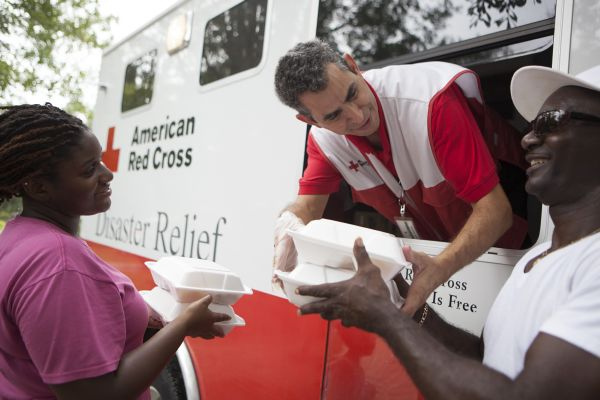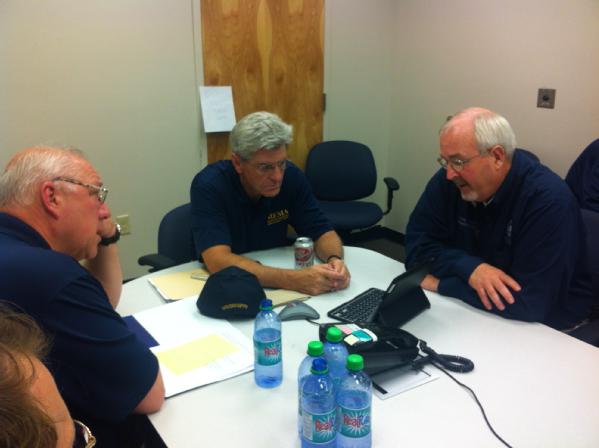We often say that FEMA is one part of the team that helps Americans prepare, respond, and recover from disasters. Over the past few weeks, this has been very evident in the response and recovery to Hurricane Isaac around the Gulf Coast. In addition to the tireless work of our federal, state, local, and tribal government partners, the support of countless non-profit and voluntary organizations has been vital in providing assistance to survivors of Isaac.
Below are three stories that demonstrate the work of a few of our non-profit partners: the Humane Society, the Salvation Army, and the American Red Cross. To learn more about their work and other organizations like them, visit the National Voluntary Organizations Active in Disasters website.
A quick message from our lawyers: We are providing the following examples for your reference. FEMA does not endorse any non-government organizations, companies or applications. The views expressed below do not necessarily represent the official views of the United States, the Department of Homeland Security, or the Federal Emergency Management Agency.
Humane Society: Pets Weather the Storm of Hurricane Isaac
Posted September 4
Hurricane Isaac hit the Gulf Coast last week–almost seven years to the day that Katrina struck that same area. Isaac’s heavy rains brought severe flooding in inland areas, and high winds and storm surges overtopped some levees, such as in Plaquemines Parish. Many people were forced to evacuate from their homes, and tens of thousands lost power.

Frank Loftus/The HSUS
One of 200 dogs and cats that The HSUS transported.
The HSUS kept a close eye on Hurricane Isaac before it made landfall--encouraging residents to take their pets with them if evacuating, providing information through social media about pet-friendly shelters, evacuation routes, and other animal-related resources, and staying in touch with emergency management officials about the needs of affected communities.
In the years since Hurricane Katrina, the enactment of a federal pets and disaster bill (the Pet Evacuation and Transportation Safety Act) and public education campaigns by The HSUS and other groups have brought important progress in preparedness and achieved a broad change in consciousness how about pets and the human-animal bond are accounted for in disasters. Last week, a video news report from WWL-TV in Louisiana commented on the changes since Katrina as they showed rescuers saving a man and his four dogs trapped by severe flooding from Isaac.
When our Animal Rescue Team received a call from Jefferson Parish, La., we deployed to assist animals at risk. We worked with Jefferson Parish Animal Shelter to help care for pets separated from their families as well as stray animals. PetSmart Charities also assisted by donating pet food and supplies. And over Labor Day weekend, our team transported more than 160 homeless pets from the shelter to our Emergency Placement Partners in several states. The Humane Society of Charlotte, N.C., also generously provided its facility as a central location for other placement partners to pick up Isaac animals from our transport. The HSUS is transporting more than 60 additional pets to Maryland where we're providing emergency care for them until they can be adopted.
In Mississippi, we worked with McComb Animal Control officers and local volunteers to rescue more than 20 horses from flood waters that would have soon overtaken the animals, and we joined with the Okaloosa County Disaster Animal Response Team to transport homeless pets from the McComb Animal Shelter to the Montgomery Humane Society in Alabama. Transports like these ease the burden on local shelters affected by disasters and give these animals a better chance of finding loving homes.
-----------------------------------------------------
Salvation Army: Mobile Kitchens Deployed to New Orleans & Slidell, LA
Posted by Megan, Salvation Army on Monday, September 3, 2012

Thanks to the generosity and prayers of our supporters – such as BP, AmeriCares, local businesses, and donors from across the country – we are continuing to provide shelter, food, hydration, and emotional and spiritual care to residents in the Gulf Coast following Tropical Storm Isaac’s arrival almost one week ago.
Thus far, volunteers and personnel of The Salvation Army have provided almost 35,000 meals and 42,000 drinks via the 25 mobile feeding units and field kitchen serving in the hardest-hit areas of Louisiana, Alabama, Mississippi and Florida.

Specifically, mobile kitchens and Salvation Army personnel have been deployed to New Orleans and Slidell, LA; Pass Christian and Hancock County, MS among other locations. For a list of canteens and shelters currently open and serving, please visit our Emergency Disaster Services page by clicking here.
Our relief efforts always involve an element of counseling, with the understanding that natural disasters such as this can be emotionally traumatizing to those impacted, specifically to Gulf Coast residents remembering Hurricane Katrina from 2005.
Throughout this last week, The Salvation Army has been providing emotional and spiritual support with 900 individuals receiving care so far.



The Salvation Army is prepared to continue serving families and individuals in the recovery process going forward so long as we are needed. Ranging from shelter and food to material requests or clean-up kits, we strive to meet the unique needs of storm survivors through your support. Because each person’s needs are different, monetary donations are the most efficient and effective way to support our disaster relief efforts.
American Red Cross: Thank You
Posted on September 4, 2012 by Erin Ferris, American Red Cross
For the last week, every single time I turned on the evening news I came face-to-face with stories about and images related to Hurricane Isaac. In the days leading up to the storm’s arrival, coverage focused on weather predictions and evacuation plans. After Isaac made landfall, coverage transitioned to updates on rainfall totals, wind speeds, and the status of the levy and pump systems. As soon as the worst of the weather had passed, newscasters spoke of the rescues, as well as the hundreds of thousands without power and the unknown number without shelter, food, clothing, and medicine.
For the last week, every single time I turned on the evening news I came face-to-face with stories about and images of American Red Cross volunteers. In the days leading up to the storm’s arrival, volunteers were preparing to transport supplies and travel to the Gulf Coast. After Isaac made landfall, volunteers were setting up and staffing shelters, providing basic necessities to those who had fled their homes with no more than the clothes on their backs. As soon as the worst of the weather had passed, volunteers were in the field, assessing storm damage and providing water, food, and comfort kits to those who’d stayed behind.
Every single time I turned on the television, American Red Cross volunteers were there, generously giving their time, sharing their skills, and offering what those who just lived through this traumatic event needed most: shelter, water, food, clothing, medicine…and hope.
So today I simply want to say thank you. To the American Red Cross volunteers who answer the call, and leave behind their own lives – their families, friends, jobs, and homes – for weeks at a time, to lift up fellow human beings in their time of need.
Thank you.



























